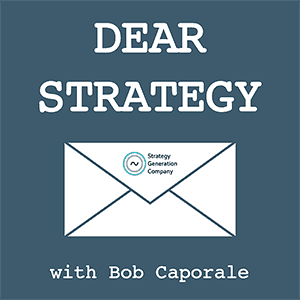Dear Strategy:
“How do I turn a disruptive threat into an opportunity – with a focus on turning the mindset of the company around from arrogance and defensiveness to embracing and taking action?”
First, a few opening observations:
Arrogance and defensiveness – these are the hallmark characteristics of successful companies that refuse to believe the world is changing around them.
Embracing and taking action – these are the desires of forward-thinking employees who are trying to save aforementioned companies from their own inevitable demise.
And, so, we have a foundation upon which I will attempt to build the answer to this question…
Here’s the way the scenario typically plays out:
Startup Company X develops a new product or technology that ends up having some level of success in the marketplace. As the market for the product grows, Company X grows with it. Despite other players flooding the marketplace with similar products and technologies, Company X maintains its leading position, continuing to expand and dominate throughout the mature stage of its natural lifecycle. Then, inevitably, the world starts to change – prompted, in part, by a dynamic new startup, Company Z, who has introduced an exciting new technology. Before long, Company X’s leading share position becomes threatened, moving them squarely into the decline stage of their lifecycle. And now Company X is faced with a choice: 1) Adapt and restart, or; 2) Cling and deny. Door #1 will lead them to a renewed lifecycle. Door #2 will lead them to a natural death. And despite that fairly straightforward (and rather unsettling) reality, company after company continue to choose Door #2.
We’ve all heard that change is difficult, which essentially means that most humans prefer to “stay put” in the face of the unknown. And, as it turns out, at least for most of us, things need to get pretty darned uncomfortable before we begin accepting the fact that we may need to make a move. And by that time, it’s usually too
By way of an example, have you ever been in a hotel room during a fire alarm? If so, how long did it take you to leave? Despite the fact that your life might actually have been in danger, you probably waited it out until the sound was too unbearable for you to stand any longer. And, even then, you probably peeked your head out the door of your room to see what other people were doing before you even thought about putting on your shoes and making your way to the nearest exit.
Needless to say, all of this is the absolute WRONG reaction, but it only serves to illustrate the fact that most of us will only move out of our respective comfort zones if and when danger is absolutely and imminently upon us. And, even then, some alarming number of us will still choose to stay right where we are.
And companies, which are only just collections of people, will, unfortunately, behave no differently. When their “fire alarms” start to sound in the form of declining sales or share, some company leaders will inevitably look for excuses to strategically stay put – especially when they can lay claim to their current actions having worked really, really well for them in the past. So they blame other factors – like an underperforming salesforce or ineffective marketing – rather than looking to the true root cause of their problem: A strategy that is in desperate need of a refresh.
And what does all of this result in? “Arrogance and defensiveness” – or at least that’s how it may appear to the naked eye.
In fact, what you’re really dealing with is that very natural human desire to “stay put” in the face of the unknown. And it is in this understanding of the problem that will also ultimately lead you to the cure…
Companies, just like products, follow normal lifecycle curves. When a company survives for more than a few decades, it’s not because it lived a really long life; it’s because it lived several of them. In other words, it restarted itself before it died its own natural death.
“When a company survives for more than a few decades, it’s not because it lived a really long life; it’s because it lived several of them. “
If you want your company to survive through more than one lifecycle curve, you generally need to do three basic things:
- Heed the warnings
- Embrace the future
- Build upon the past
Heeding the warnings is about accepting your natural decline rather than refusing to believe that it exists.
Embracing the future is about understanding the needs of an advancing marketplace and introducing new products and technologies that can speak to those needs.
Building upon the past is about using your company’s experience as a foundation for a new future rather than as an anchor for trying to re-live the past.
If you are a strategic manager who is trying to convince your leadership to “embrace and take action,” try approaching the situation using these same three steps. Companies that consistently rebuild themselves tend to follow this pattern, while companies that fizzle out tend to fail on one or all of these points. You can have a listen to the podcast episode for some examples of each; but, let’s face it, you know who they are. And, by the way, so do your leaders – which is why they’ll probably listen to you when you approach this problem in a non-emotional way.
With all of that said, let’s revisit our opening observations:
Arrogance and defensiveness – these are actually the natural responses from company leaders who are too afraid (or who don’t know how) to change.
Embracing and taking action – these are actually the characteristics of forward-thinking employees who are willing to help their leaders reinvent their respective companies in the face of a declining lifecycle.
Try giving that approach a go, and see if it doesn’t make some difference.
Listen to the podcast episode
Dear Strategy: Episode 089

###
Are you interested in strategy workshops for your product, marketing, or business managers? If so, please be sure to visit Strategy Generation Company by clicking the link below:
 Bob Caporale is the founder of Strategy Generation Company, the author of Creative Strategy Generation and the host of the Dear Strategy podcast. You can learn more about his work by visiting bobcaporale.com.
Bob Caporale is the founder of Strategy Generation Company, the author of Creative Strategy Generation and the host of the Dear Strategy podcast. You can learn more about his work by visiting bobcaporale.com.






